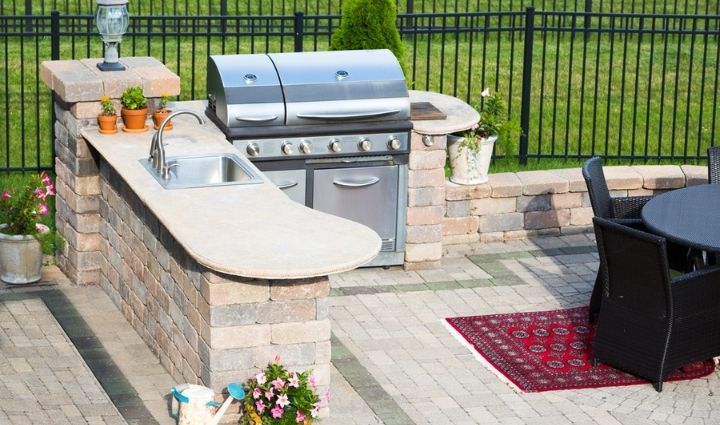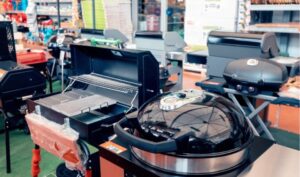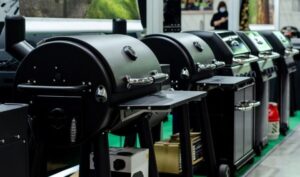This is Part 4 of GrillSpot’s Ultimate Gas Grill Buying Guide, where we’ll cover everything you need to know about how to buy a gas grill, from what factors you need to consider to detailed guides dedicated to everything from budget to grill size to BTUs.
In terms of mobility, there are two main styles of grills to choose from: freestanding grills and built-in grills. In this guide, we’ll explain the difference between these two types of grills, and offer our advice for what option will work best for you.
When comparing freestanding or stand-alone barbecue grills to built-in grills, it’s important to remember that one is not necessarily superior to the other, but one will suit your specific situation better. Both types of grill come with a variety of fuel source options (such as charcoal, gas, natural gas) and myriad add-ons for you to explore. Whatever you plan to cook, both types of grill will get the job done.
Let’s pop the lid and take a look at what’s cooking with each of these grill types:
Freestanding Gas Grills
Freestanding BBQ grills, also called stand-alone grills or—for smaller models designed for transport—portable grills, are mobile grills built onto wheeled carts that typically also feature storage compartments. They are the most popular type of grill and can run off of natural gas, propane gas, charcoal, pellets, or a combination of these sources.
Freestanding grills are typically less expensive than most built-in grills, depending on which freestanding model you opt for. Higher-end freestanding grills with a large cooking space and lots of added features, such as rotisseries or infrared burners, will be more expensive and closer in price to built-ins grills. However, there are also many very capable lower-end models with fewer features for those with a smaller budget, want a grill that can move around, or who don’t have a dedicated outdoor kitchen.
Because they are mobile, you can easily rearrange your patio to accommodate a new layout in the event that you get new patio furniture or a second grill, need to accommodate additional seating for a party, or if you want to put it in storage for the winter.
Advantages
- Generally cheaper with various prices to fit any budget
- Moveable
- Smaller sizes available
- Bigger selection
- Easy, fast set up
- Less of a commitment
Disadvantages
- Not every type of freestanding grill is capable of being put into a grill surround
- Less durable than a built-in
A freestanding gas grill is ideal for those who:
- Have limited space
- Are working with a lower budget
- Desire more flexibility in grill placement
- Are not looking for a permanent structure
- Are renting their home
Built-in Grills
Built-in gas grills are designed, tested, and manufactured specifically to be built into structures like outdoor kitchen islands. As such, their design must factor in things such as ventilation and durability—they need to be able to function safely and weather the elements, after all.
Because of these considerations, built-in grills are typically more costly than freestanding grills. The price range varies depending on whether you opt for a prefabricated model or a custom build, how large the grill is, and how many special features and add-ons it includes. However, built-in grills typically last longer than freestanding grills, so the upfront cost should pay off over time.
GRILL SPOT TIP: When it comes to buying built-in grills, you need to carefully consider which grill you want and its specifications—not just for now, but in the long term as well. In the event that you decide to upgrade or you need to replace your grill, you will be limited by the size and shape of the cutout in your outdoor kitchen counter unless you opt to modify your island, which can increase the cost significantly.
The cost of a built-in grill will be significantly higher than a freestanding grill if you add in the cost of the entire outdoor kitchen, including things like levelling the earth and paving the area, as well as contractor fees and permits you will need to build it. If you’re considering building an outdoor kitchen, it is important to remember that it is an investment—an outdoor kitchen is a desirable feature that can increase your property value, and a built-in grill is its centerpiece.
GRILL FACT: Do not forget to check with your local municipality (or, if applicable, homeowner association/condo board) to confirm if there are any restrictions on what kind of grill you can install.
Advantages
- Permanent structure
- Adds value to your home
- Durable and long-lasting
Disadvantages
- Immoveable
- More costly
- Time consuming to set up
- Typically requires permits and contractors
A built-in BBQ grill is ideal for those who:
- Have the space and desire for an outdoor kitchen setup
- Are working with a higher budget
- Have the time to wait for it to be built
- Love to grill all year round
- Don’t mind a stationary grill
- Will be staying in their home for the foreseeable future
How to Make a Freestanding Grill Look like a Built-in
If you don’t want to shell out the money for a built-in grill, it is possible to convert a freestanding grill to built-in in appearance by building a grill surround. When constructing a grill surround, it is important to use materials that are fireproof, such as bricks and mortar or concrete, and to build it in an open area or one with proper ventilation.
SAFETY NOTE: When undertaking this project, you must be careful to consider safety and ventilation, as well as the strength and integrity of the grill itself.
Not all freestanding grills can be converted to built-in grills this way. In some situations, placing your freestanding grill into a built-in setup may not be safe, as they are not tested or built with this type of use in mind, and it may even void your warranty. Be sure to check with your manufacturer to see if they have approved this type of conversion and what the recommended clearances are around the grill to maintain sufficient airflow.
In many cases, a freestanding grill will have to fit into the new surround as-is, removing only unnecessary pieces from the structure such as the folding sides—otherwise, you risk damaging the structural integrity of the grill and can render it unsafe to use. Measure carefully before making your building plans, keeping in mind that you will need to be able to access the fuel source, and make sure you avoid inadvertently sealing your grill into the surround. Otherwise, you lose the mobility and flexibility that freestanding grills provide, and taking it out in the event it needs maintenance or replacing will be more challenging.
If learning how to build a BBQ grill surround is something you want to undertake, there are lots of options, ranging from simple DIYs to more complex projects:
- 12 DIY BBQ Island Plans at The Spruce
- How to Build a Grilling Island from HGTV
- How to Build a Grilling Island from Lowes
Conclusion
When it comes to freestanding grills vs. built-in grills, the grill that is right for you ultimately depends on your living situation, budget, and your goals for the grill.
Freestanding grills are best for those:
- With limited space
- With a lower budget
- Who desire more flexibility in grill placement
- Not looking for a permanent structure
- Renting their home
Built-in grills are best for those:
- With the space and desire for an outdoor kitchen setup
- With a higher budget
- Who have the time to wait for it to be built
- Who love to grill all year round
- Who don’t mind a stationary grill
- Staying in their home for the foreseeable future





